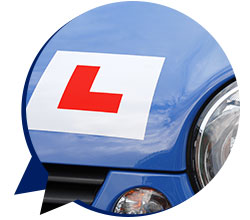Private driving practice – advice for parents
 Learning to drive is much more than just a physical skill of knowing how to control the car and recognising traffic signs. To pass your test and to be a safe driver requires the ability to read the road, to spot hazards and to react accordingly. Therefore, getting as much practice as possible to support the work of the ADI is really important. While you may initially feel apprehensive supervising a learner driver, it’s important not to allow your nerves to create an assertive, controlling or intimidating atmosphere. The following information will help non-ADIs to provide effective private practice.
Learning to drive is much more than just a physical skill of knowing how to control the car and recognising traffic signs. To pass your test and to be a safe driver requires the ability to read the road, to spot hazards and to react accordingly. Therefore, getting as much practice as possible to support the work of the ADI is really important. While you may initially feel apprehensive supervising a learner driver, it’s important not to allow your nerves to create an assertive, controlling or intimidating atmosphere. The following information will help non-ADIs to provide effective private practice.
Are they ready for a private practice?
Before you take them out, it’s important to talk to their ADI, who should be able to advise you as to when the learner driver is ready to begin private practice. It’s better not to take them out until they’ve mastered the basics of car control and can carry out an emergency stop.
Planning the private practice drive
It’s not just a case of going out for a drive. Rather, it’s important to speak to your child’s ADI and plan to reinforce what the learner driver has been taught; the purpose of private practice is to give the learner driver experience NOT to teach them new skills. Remember, what you were taught may no longer be valid.
The first time you take out a learner driver avoid busy traffic and complex junctions and roundabouts. Plan a quiet route and gradually increase the length and complexity, as both you and the learner driver become more confident. The ADI might also be able to suggest some appropriate routes.
As the learner becomes more competent, design routes that encompass both urban and rural roads and if possible take them out at night. As they progress towards test standard, practice using a sat nav, getting them to follow the pre-set instructions and give them the opportunity to drive to the shops, to take you to work or an appointment.
Coaching tips
By following these few basic suggestions the private practice sessions will be an enjoyable and rewarding experience for all.
- Remain calm and be positive at all times (sometimes easier said than done!)
- Give instructions and directions well in advance. Be clear and specific to avoid any confusion. Your instructions should be designed to do one of three things:
- Alert: Them to a situation
- Direct: “At the next junction I want you to turn right”
- Identify: “When it is safe to do so I want you to...”
- Ask questions to check whether the learner is seeing what you are seeing, such as a developing hazard
- Ask them to explain what they would do, problem solving rather than just following instructions
- If a dangerous situation developed pull over at the next safe place and discuss the incident, what happened, why and what they would do in the future to avoid a repeat
- In your rush to get started, don’t forget the pre drive cockpit check: doors closed and secure, seat and mirrors adjusted and the driver can reach the steering wheel without stretching.

What should you teach?
To help in the supervised drive we have produced a coaching sheet.
After the drive
It’s important to make time at the end of the drive to go over the lesson. Talk about what went well at first and be positive. Ask them how they felt it went and whether there was anything they would like to improve upon next time. Use the technique; praise – constructive criticism – praise
Initially when taking out a learner driver there are likely to be a number of minor faults. It’s better to leave these until later and to focus on the more major ones, so that they are not discouraged.
Keep a record of what is covered in the drive and the main action points to work on next time. This can be a few simple notes with a date, manoeuvres covered and agreed actions. Alternatively, the DVSA driver log book can be used .
RoSPA has produced a downloadable booklet: Helping Young People Learn To Drive Safely which includes some of the above information.